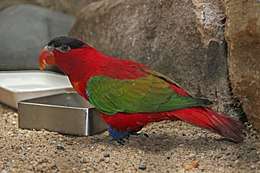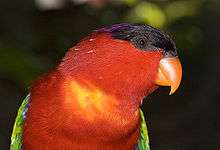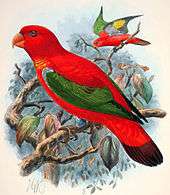Purple-naped lory
The purple-naped lory (Lorius domicella) is a species of parrot in the family Psittaculidae.[2] It is forest-dwelling endemic to the islands of Seram, Ambon, and perhaps also Haruku and Saparua, South Maluku, Indonesia. It is considered endangered, the main threat being from trapping for the cage-bird trade.
| Purple-naped lory | |
|---|---|
 | |
| At Natura Artis Magistra (Artis Zoo), Netherlands | |
| Scientific classification | |
| Kingdom: | Animalia |
| Phylum: | Chordata |
| Class: | Aves |
| Order: | Psittaciformes |
| Family: | Psittaculidae |
| Genus: | Lorius |
| Species: | L. domicella |
| Binomial name | |
| Lorius domicella | |
| Synonyms | |
| |
Description


The purple-naped lory is 28 cm (11 in) long. It is mostly red with an all red tail that fades to darker red towards the tip. The top of its head is black, which fades to purple on the back of its neck. It has green wings, blue thighs, and a variable approximately transverse yellow band across the chest. It has an orange beak, dark-grey eyerings, and orange-red irises. Juveniles have a brown beak, grey-white eyerings, brown irises, a wider yellow band across the chest, and a more extensive purple patch on the back of neck.[3]
References
- BirdLife International (2013). "Lorius domicella". IUCN Red List of Threatened Species. 2013. Retrieved 26 November 2013.CS1 maint: ref=harv (link)
- "Zoological Nomenclature Resource: Psittaciformes (Version 9.022)". www.zoonomen.net. 28 March 2009.
- Forshaw (2006). plate 17.
Cited texts
- Forshaw, Joseph M. (2006). Parrots of the World; an Identification Guide. Illustrated by Frank Knight. Princeton University Press. ISBN 0-691-09251-6.
